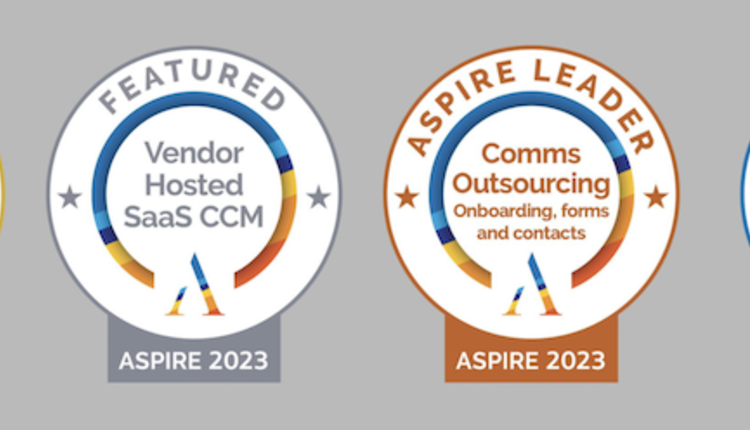This article appears in the Spring 2018 magazine issue of DOCUMENT Strategy. Subscribe.

When we look at the underlying technology of CCM, there is a wide range of software categories involved in creating, managing, and fulfilling customer communications. This is because CCM does not have a universally defined scope. To better understand the nuances between these technologies, we classify CCM solutions into four main categories: Automated Document Factory (ADF), customer communications, business automation, and omni-channel orchestration.
1. Automated Document Factory (ADF)
ADF solutions provide lights-out, high-volume print output and are closely linked to output management, archiving, and page description language (PDL) transforms. Representative vendors in this market include Canon, Compart, Crawford Technologies, Pitney Bowes, Ricoh, and Xerox. This segment is very mature, as print volumes continue to decline in the Western world. While the production has completely moved to color and inkjet printing in recent years, there is still some innovation taking place on the software side.One such innovation is supply chain integration, which is largely driven by the need to track and trace print items deep within the postal delivery system. We are now seeing services in the US and Europe that track and scan mail pieces as they are processed in the postal providers’ sorting centers. The captured data and images are then delivered to consumers through a mobile app, offering them a preview of the mail for that day. This development opens up new opportunities for omni-channel and geolocation marketing services as well and can also help to improve the customer experience by pulling mail from the system that should no longer be delivered (e.g., in case of a deceased recipient).
Another advancement in ADF solutions is the move toward cloud computing and interactive reporting. For example, there are some interesting use cases of European service providers opening their production planning services to customers, which allows users to control what’s printed, the date of the job, and the quality (or cost) level. This helps customers to align the production process with their internal operations, such as call center capacity levels.
2. Customer Communications
Customer communications solutions include traditional document composition vendors, such as OpenText, Quadient (formerly GMC Software), XML-based cloud vendors such as Smart Communications and TopDown Systems, as well as more specialized providers like Messagepoint, Striata, and XMPie by Xerox. Most composition vendors in this category have evolved their platforms to be digital-first, leaving the term “document composition” somewhat obsolete. Like many other software providers, this group has introduced cloud-based solutions to enable online design and authoring experiences for business users and to support faster, more cost-effective deployments.These solutions are also accelerating the move toward mobile and web experiences through rapid development frameworks and low-code/no-code programming. Leveraging microservices and API-based architectures, they embed a centralized customer communication editing experience into other systems (think Salesforce Marketing Cloud for email campaigns, Adobe Experience Manager for web experiences, or Guidewire for online claims management).
The development of content management for business users in these solutions offers direct control over what and where this content is used. Implicit approval rules, which are powered by machine learning technology, allow the business user to control the content flow, approval processes, and compliance with brand and regulatory guidelines.
Lastly, we expect the ability to embed new interaction technologies, such as personalized videos, personal virtual assistants (e.g., Siri, Cortana, and Echo) and chatbots, within our communications to be generally available throughout 2018 and 2019.
3. Business Automation
Business automation solutions help to speed up business processes around negotiated documents, case management, or business workflows in general, some of which are very specific to certain industries. Some vendors of note in this category are Adobe, ISIS Papyrus, Kofax, OpenText, and Objectif Lune.Developments within this segment include intelligent ways to capture and extract data; digitizing the entire account creation, activation, and onboarding experience; electronic payments and bill pay services, robotic process automation, and machine learning technology.
Enterprise integration platforms are being developed as effective middleware to connect all the various systems within the CCM ecosystem. This middleware then tags communications and centrally stores them for further processing and analysis. Some potential use cases for these solutions include a 360-degree view of the customer, next-best action recommendations to drive business outcomes, or visualization of touchpoints with journey mapping software. This area will evolve significantly in the years ahead, and it can offer even greater value by linking it to concepts such as value stream mapping and voice of the customer (VOC) feedback. Companies such as Adobe, ISIS Papyrus, OpenText, Pitney Bowes, and Quadient play in this area, with several other vendors expecting to enter the space in the years to come.
As you can see, the CCM industry is no longer print- and document-centric. This market is moving toward centralized communication platforms that operate across siloes, support complex and regulated use cases, and leverage online template editors that are tailored to the requirements and job role of the user.
4. Omni-Channel Orchestration
Finally, omni-channel orchestration solutions aim to understand the intent and context of communications. Heavily based on data analytics, machine learning, and artificial intelligence, they provide insight around the best ways to interact and communicate with customers to meet business objectives.Enterprise integration platforms are being developed as effective middleware to connect all the various systems within the CCM ecosystem. This middleware then tags communications and centrally stores them for further processing and analysis. Some potential use cases for these solutions include a 360-degree view of the customer, next-best action recommendations to drive business outcomes, or visualization of touchpoints with journey mapping software. This area will evolve significantly in the years ahead, and it can offer even greater value by linking it to concepts such as value stream mapping and voice of the customer (VOC) feedback. Companies such as Adobe, ISIS Papyrus, OpenText, Pitney Bowes, and Quadient play in this area, with several other vendors expecting to enter the space in the years to come.
As you can see, the CCM industry is no longer print- and document-centric. This market is moving toward centralized communication platforms that operate across siloes, support complex and regulated use cases, and leverage online template editors that are tailored to the requirements and job role of the user.
This modern orchestration of messages involves integrating CCM to other systems in the ecosystem, tagging the output, and using customer engagement technology to successfully communicate and interact with our customers.
Kaspar Roos is the Founder and CEO of Aspire Customer Communications Services, an international technology advisory firm specializing in customer communications transformation and customer engagement optimization. Before starting Aspire, he ran InfoTrends’ global production workflow and customer communications advisory service. Follow him on Twitter @kasparroos.













